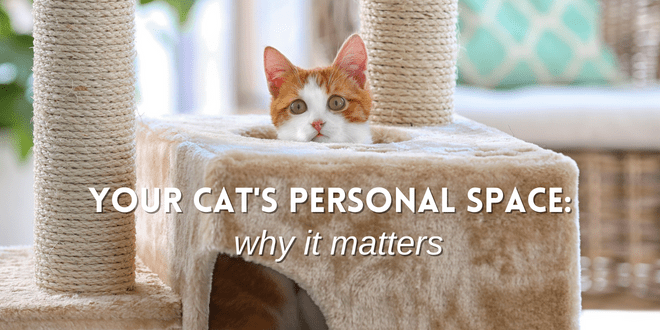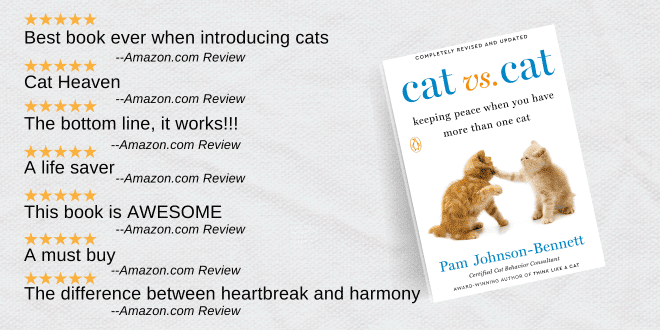
When it comes to our personal space, we feel most comfortable when we have control over how much we need. For instance, it’s much more pleasant to enter a waiting room that isn’t crowded, allowing us to choose where to sit and the distance we want from others. Isn’t it a relief to board a subway or elevator that isn’t packed? Having to squeeze into a crowded space can be uncomfortable and even anxiety-inducing for many. Plus, who among us doesn’t make every effort to avoid the dreaded middle seat on an airplane?
You may not think cats have much to worry about when it comes to personal space concerns, especially if you have a cat who always snuggles up close to you at night. Even though your cat may seem like a Velcro kitty, he still wants control over personal space preferences. Overlooking these subtle choices can impact your cat’s happiness and behavior. Here are just a few key areas where allowing your cat to have personal space choices can significantly influence well-being, behavior, and the bond you share.
New Cat Introduction
Human family members often make the mistake of rushing cats to become instant friends. Although cats are social animals and most benefit from having a feline friend, they need the option to slowly evaluate the new situation and proceed at a comfortable pace. Cats are territorial and the sudden addition of a newcomer triggers concern for potential turf threat, physical safety and resource availability.
Give the cats a choice in the pace of the introduction. Ensure they always have the option to retreat to their safe zones and maintain the security of personal space. This will greatly increase the chances of a successful friendship.
If you put the cats together to “work it out” or take away their opportunities to choose the pace and distance, you raise stress levels and it keeps them in high-threat mode. They should decide how much space they need between each other. Your job is to make sure to start out well within their comfort zones and proceed in baby steps so each cat feels comfortable. If you force them to share an uncomfortably close space, you’ll have basically just hit the feline panic button.
When doing a new cat introduction, give them a reason to like each other by creating positive associations. All the while, give them the choice of how quickly to proceed and how close they want to get to each other. Each cat needs the option to retreat to a safe zone.
Your Cat’s Social Interaction with People
It’s totally understandable to want your cat to enjoy being around guests in the home. Be careful though that in your effort to show him he has nothing to fear, you don’t increase anxiety.
I’ve seen cat parents pull the cat out from under the bed in order to place him in the arms of a cat-loving visitor. From the cat’s point of view, he has just been abruptly dumped into a highly dangerous position. He is being held by someone who doesn’t smell at all familiar and the cat hasn’t had time to determine whether this stranger is harmless or threatening. When social interaction such as this is forced, it raises the cat’s reactivity level which may lead to unwanted aggression. It certainly will make him more reluctant to come out of hiding the next time the doorbell rings. If you take away the cat’s choice of how to handle personal space it may result in him needing even more in the future.
Give your cat the choice of whether he wants to be a social butterfly, a bystander or not present at all. If your cat reluctantly enters the room, don’t scoop him up and force the issue. Instead, instruct your guest to completely ignore the cat. This gives the cat the option to tip-toe closer and do a scent investigation or to stay on the perimeter of the room. When your cat feels he has control over his space, it becomes a stepping stone that sets the tone for future visits.
Your Cat’s Litter Box
It may not seem as though concern for safety is something an indoor cat would have to worry about when in the litter box, but how and where a box is set up can create a sense of security or a concern for safety. How do you provide personal space in terms of a litter box? Start by having enough litter boxes so cats have a choice to use the one in a location where they feel safest. In a multicat household, a lower ranking cat may not feel safe enough if they have to cross an opponent cat’s preferred area in order to get to the box. Offer choice by having more boxes than cats. Typically, the boxes should outnumber cats by one. Spread the boxes throughout the house to ensure each cat’s personal core zones are covered to address resource security concerns.
Your Cat’s Vertical Territory
Cats live in a world of vertical territory. For some cats, the vertical location is desirable because it enables them to have a good view of things happening outdoors. For others, it provides a visual advantage to see if something or someone threatening enters the area. Having access to the highest perch can be a show of status and may reduce actual aggressive encounters in a multicat household. For a fearful cat, having an elevated, out of reach area can provide safety from small children or dogs.
In a multicat environment, provide adequate vertical choices because some cats may not want to share the same spot or be physically close. One of the keys to peaceful multicat co-existence is when cats can comfortably choose the distance they want between them. If the only vertical territory is in the form of a single cat tree, then only one cat may be happy. Create multiple options for vertical territory so each cat can find a prime top spot. Even if you live in a small apartment you can provide more personal space for your cat by making use of vertical territory. Cat trees, wall shelves, window perches, or even beds placed on various pieces of furniture can provide cats with enough distance between each other to create personal space.
Your Cat’s Mealtime
Cats aren’t social eaters the way we are. We love to sit around the table together and have a good conversation while we eat. Cats? Not so much. Resource security is what cats are looking for when they eat. If you have a multicat environment, don’t insist the cats eat out of one big food bowl. If you separate bowls, don’t place them right next to each other. Give the cats room enough so no one has to worry about whether a companion cat is going to try to swipe some food. Depending on the relationship your cats have, the distance between bowls can be relatively close or maybe they need to be on opposite sides of the room. One cat may feel more secure eating on an elevated surface or even in a separate room. Offer enough space so mealtime is peaceful and not an intimidation contest.
Need More Information?
For more specific information on cat behavior and training, refer to the best-selling books by Pam Johnson-Bennett. Pam’s books are available at bookstores and online. We’ve included links to Amazon here on our website. To learn more about creating personal space in a multicat household, check out the revised and updated edition of Pam’s best-selling book, Cat vs. Cat. It’s the first book totally dedicated to creating peace and harmony when you live with more than one cat.
If you have a question about your cat’s health, contact your veterinarian. This article is not intended as a medical diagnosis nor is it a replacement for your cat’s regular veterinary care. This article is for general information purposes only.

